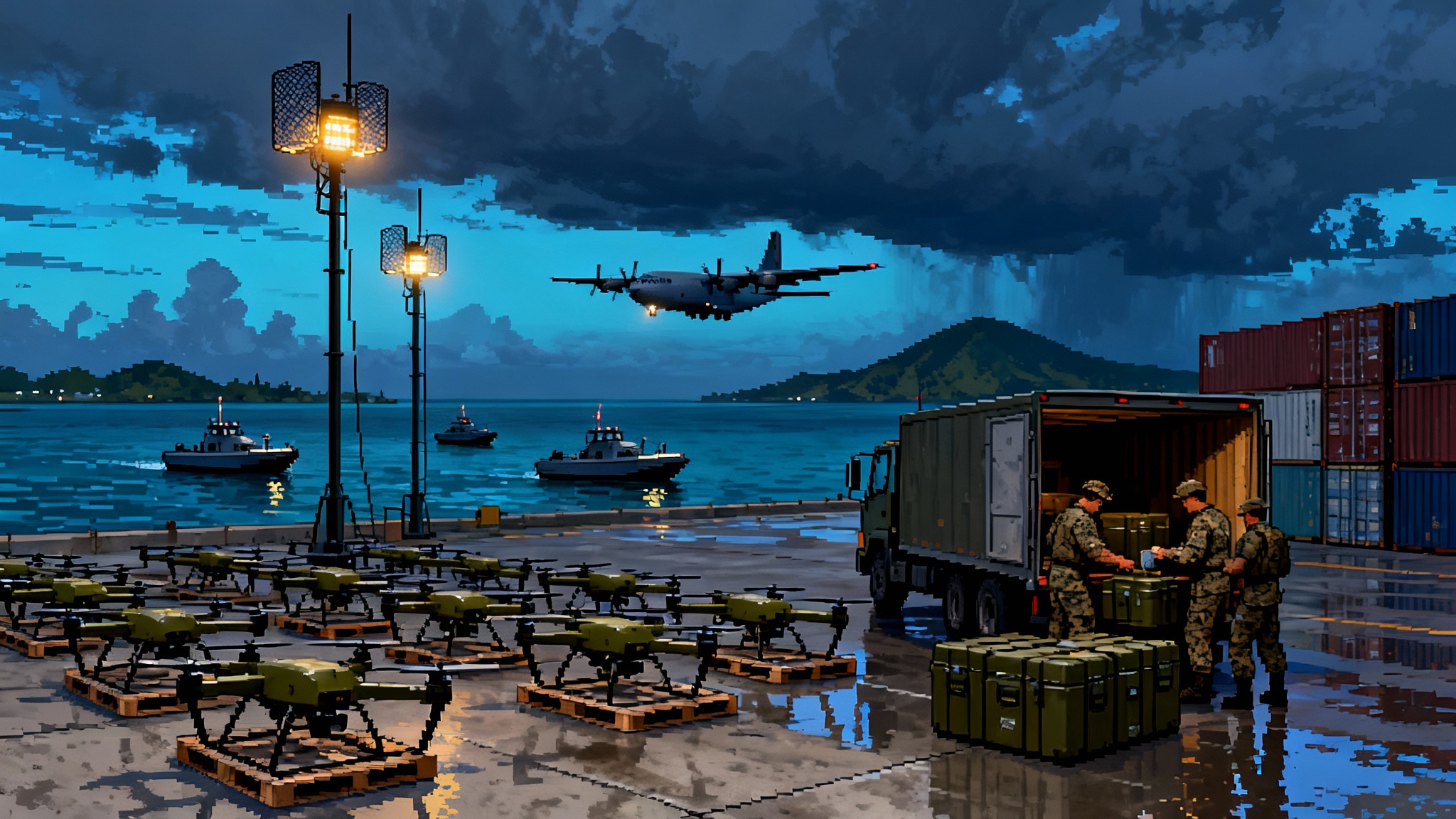EA-37B goes live: G550 jammers rewrite allied EW
On May 2, 2025, the EA-37B Compass Call launched real training from Davis-Monthan, and by July Italy ordered two G550-based jammers. Powered by SABER software, these fast jets aim to mass network-kill effects with allies.

The new shape of airborne jamming
The United States Air Force quietly crossed a line on May 2, 2025, when the EA-37B Compass Call flew its first mission-training sortie from Davis-Monthan Air Force Base. The service published the milestone the following week, confirming the aircraft had begun real training missions that move it from a test article to a fielded capability first training sortie confirmed. Two months later, Italy signed a deal to join the club, buying two Gulfstream G550-based electronic attack aircraft built around the same Compass Call mission system. That was the first approved export of the EA-37B architecture, and it signaled that stand-off electromagnetic attack is about to scale across the North Atlantic Treaty Organization.
That sequence tells a larger story. Airborne electronic warfare is shifting from slow, low-altitude haulers to fast, high-altitude business-jet platforms that can orbit at range, update software rapidly, and team with crewed and uncrewed escorts. Think of it as replacing a diesel generator with a fleet of quiet, high-efficiency battery packs that can be stacked, redeployed, and reprogrammed at will. The EA-37B is the tip of that spear.
From lumbering haulers to fast strikers
For decades the EC-130H Compass Call did the heavy lifting in United States electronic attack. It was capable, proven, and globally deployed, but it was also a large turboprop that had to get relatively close to hostile air defenses. The airframe’s speed and altitude limited where and how long it could safely loiter. Crews and maintainers wrung every ounce of performance and reliability out of it, yet the strategic problem changed around the aircraft. Adversaries built longer-range surface-to-air missiles, moved emitters more often, and shifted critical communications to agile and encrypted networks.
The EA-37B answers those pressures by moving the Compass Call mission system onto a Gulfstream G550. That brings jet speed, higher ceilings, and much longer unrefueled range for stand-off operations. A smaller radar cross section, better climb and dash performance, and commercial reliability make it easier to be where it needs to be without being where the enemy expects it. In modern electromagnetic warfare, position is power, and the G550 buys options.
What EA-37B actually does
Compass Call is designed to deny, degrade, and disrupt adversary command and control. In practical terms that means three families of effects:
- Communications denial: Jamming or deceiving radios, data links, and cellular networks to break the threads that connect units and sensors. If a brigade cannot pass orders or targeting updates, its tempo collapses.
- Navigation attack: Spoofing or masking satellite navigation signals so weapons and vehicles drift or do not arrive. Even small errors detune artillery, unhinge drone swarms, and create friendly-fire risk for opponents.
- Radar confusion: Flooding or tricking radars so they see ghosts or nothing at all. That opens attack corridors and lowers the probability that defenders can fuse tracks into a coherent picture. Systems such as LTAMDS 360 degree radar illustrate the modern sensor networks these effects must disrupt.
Compass Call does not just blast noise. It uses receivers to find and characterize emitters, then applies tailored waveforms to impose specific problems. Where a brute-force approach is a fire hose, EA-37B aims to be a set of spray nozzles that can switch patterns, pressures, and additives in milliseconds. The point is not radio-frequency spectacle. It is to quietly turn a well-oiled enemy network into a room full of people talking over one another while the lights flicker and the map on the wall shows the wrong city.
SABER and the rise of software-accelerated EW
The reason this move to a smaller, faster jet works is not only the airframe. It is the mission system’s open architecture and software acceleration. The backbone is known as SABER, short for Small Adaptive Bank of Electronic Resources. SABER converts functions that were once locked in dedicated hardware into software-defined applications riding on a common pool of radios, processors, and interfaces.
That shift has three big consequences:
- Speed of upgrades: New threat waveform observed today, software patch in days or weeks rather than months. Crews get a new mode as simply as they get a new version of a phone app, validated and rolled out via secure pipelines.
- Modularity and competition: Open interfaces invite third-party algorithms. If a small company writes a better demodulator or a quicker geolocation routine, it can plug in without overhauling the airplane. Government owns the integration framework and can adjudicate what gets fielded.
- Resilience and capacity: Software lets the system retask on the fly. If the radar fight quiets down but the communications fight spikes, SABER reallocates processing to the problem that matters most.
The result is a mission system that learns and adapts over its life rather than freezing the day it leaves the factory. It treats radio-frequency problems as code problems. That is why the EA-37B matters as a platform and as a process.
Why speed and altitude multiply effect
A G550 at altitude sees farther and hears more. Line-of-sight to a target emitter increases with altitude, and higher ground speeds allow the aircraft to slide around weather, threat rings, and positional geometry faster. That geometry is not abstract. Effective jamming depends on the ratio of energy at the target receiver from the jammer versus the intended transmitter. Closer range, higher gain, or cleaner bearings tilt that ratio. A jet that can live at 45,000 feet and reposition quickly can keep that ratio favorable while staying outside the heart of the threat envelope. Less time defending itself means more on-mission time solving the opponent’s network.
Italy’s buy and what it unlocks for allies
On July 21, 2025, L3Harris announced a 300 million dollar contract with Italy for two G550 aircraft provisioned for an electromagnetic attack system. The deal, done with BAE Systems as a partner, represented the first time the United States approved an EA-37B sale to an ally Italy’s EA-37B contract announced. Italy already operates other G550 special mission variants, which smooths training and maintenance. Adding electronic attack on the same commercial jet creates a NATO-relevant template: common airframe, common mission architecture, national payload tailoring.
This is not just about two airplanes. It is about creating a pool of interoperable standoff jammers across the alliance. Those aircraft can share tactics, techniques, and procedures, a waveform library, and a test and evaluation playbook. When one nation pushes a new software tool into the SABER environment, others can adopt it in days after security checks, and everyone immediately gets better at the same fight.
Teaming with Growlers, uncrewed escorts, and JADC2
The EA-37B is not alone. The United States Navy’s EA-18G Growler will continue to escort strike packages and kick down doors with its Next Generation Jammer pods. The two approaches are complementary. The Growler operates closer and faster at the point of contact, while the EA-37B provides persistent wide-area effects at range. When they are in the same operational plan, the stand-off jets can blind sensors and networks so the escorts and strikers see fewer threats, and the escorts can carve corridors so the stand-off birds can hold their orbits where they do the most good.
Uncrewed escorts will multiply this further. Collaborative combat aircraft can carry compact jammers or electronic support payloads, act as forward pickets for emitter detection, and sling expendable decoys. They can push closer to riskier emitters with less concern about attrition, feeding targeting to the G550s and Growlers. See how cheap autonomy is scaling in Replicator's cheap autonomy push.
Tying the team together is Joint All-Domain Command and Control, the Pentagon’s push to connect sensors and effectors across services and allies. For electronic warfare, JADC2 means the jammer does not have to see everything or decide everything. It can subscribe to a shared picture and be tasked against specific emitters with confidence. Space-based layers like LEO communication layers strengthen the data backbone that cues and coordinates effects.
How network-kill could scale by 2027 to 2029
The phrase network-kill sounds dramatic, but the operational logic is straightforward. Instead of trying to destroy every individual system in an integrated air defense, you target the glue. If the nodes cannot talk, cannot navigate, cannot trust their radar picture, the network stops behaving like a network.
Here is a concrete pathway to massing that effect by the 2027 to 2029 window:
-
Field and integrate multiple EA-37B units. The United States completes its first tranche and pushes more crews through training. Italy receives its first aircraft in the latter part of this window, adding allied sorties to a shared playbook. Air forces standardize on common procedures for waveform management, emissions control, and deconfliction.
-
Build a shared software factory for SABER. A United States-led coalition establishes a cleared development pipeline where government and vetted industry partners push modular apps into a common baseline. Nations choose which modules to turn on, but the interfaces are the same. A new demodulator or deception technique rides the same update path to United States and Italian jets.
-
Practice distributed electronic attack. NATO exercises rehearse placing EA-37Bs on opposite sides of a theater and Growler flights along ingress routes. Uncrewed assets throw out bait, force threat radars to light up, and cue precise jamming. The goal is not one perfect bubble. It is a series of overlapping, time-synchronized effects that keep the opponent’s network constantly reeling.
-
Close the loop through JADC2. Electronic support measures from all players feed into a shared picture. Automated tools score which emitters matter most in the next fifteen minutes. Tasking flows back out as machine-readable assignments that SABER-equipped aircraft execute with minimal voice chatter. The net effect is tempo. Your jamming shifts faster than their operators can adapt.
In that construct, a handful of business jets and escorts can neutralize chunks of an adversary’s awareness at theater scale for decisive windows. The kill is on the network, not the node.
What to do now: three concrete moves
-
Invest in common standards and classification pathways. Open architecture only matters if partners can share code and data. Defense ministries should pre-negotiate classification tear lines and adopt modular open systems standards for radio-frequency hardware and software. Action: stand up a joint software integration cell with a cross-border authority to field updates inside 30 days from submission.
-
Train to electromagnetic maneuver, not just protection. Most air forces still emphasize avoiding detection over actively shaping the spectrum. Shift syllabus hours toward coordinated jamming, deception, and emissions baiting with live-virtual-constructive tools. Action: add an electronic warfare commander role in major exercises who owns a joint spectrum plan the way an air tasking order owner manages sorties.
-
Build digital twins of the adversary network. Air forces should maintain executable models of target networks that include equipment mixes, training levels, and likely operating modes. Test every SABER update and Growler tactic against these models before a line crew sees it. Action: require every new waveform or effect to pass a go or no-go in the model before fielding.
The risks and how to manage them
-
Counter-adaptation. Adversaries will hop frequencies, harden links, and push fiber deeper. Response: make the software pipeline the advantage. Do not chase every mode with bespoke hardware. Keep the interface stable so new code drops can keep pace.
-
Fratricide in the spectrum. Jamming your own links is an ever-present risk as more nodes radiate. Response: adopt a formal spectrum coordination process inside JADC2 where each mission package gets a spectrum plan with time and frequency allocations. Enforce emissions discipline and telemetry on every jammer.
-
Overclassification and export lags. If partners cannot get the good stuff, the coalition fights with mismatched tools. Response: write exportable modes from the start. Tiered effects let allies fight with modes that are interoperable and effective without exposing the crown jewels. Build the policy as part of the program, not after it.
Why this is a breakthrough, not a niche upgrade
Moving Compass Call to the G550 did more than improve fuel burn and climb rate. It made electronic attack a software enterprise with a coalition runway. The May 2 sortie put that enterprise in motion, and Italy’s July commitment showed that allies are ready to stand up their own nodes on the same network of networks. The details that matter are not just antennas and racks. They are update cadence, interface control documents, and who gets to publish a new waveform into the baseline.
If the alliance treats that software backbone as the center of gravity, then by the late 2020s it can combine stand-off EA-37Bs, escorting Growlers, and forward uncrewed pickets into a force that routinely turns off the enemy’s nervous system when and where it matters. Not forever, not everywhere, but long enough and often enough to open doors.
The closer
Air forces once measured electronic attack by the size of the airplane and the number of pods. The better metric now is the speed of the software and the quality of the team. The EA-37B’s first training sortie and Italy’s buy are not isolated milestones. They are the first pages of a playbook where the United States and its allies mass precise network-kill effects at operational scale. The platform is a G550. The weapon is code. The payoff is a battlefield where the enemy’s screens go dim at the moment you choose.






